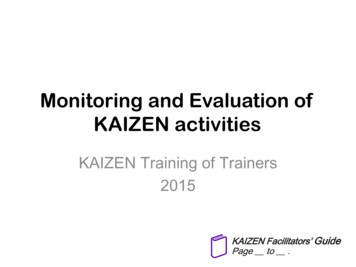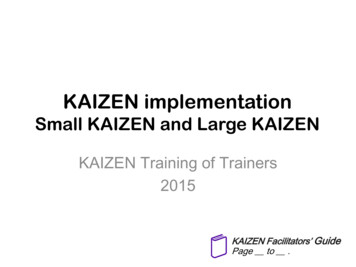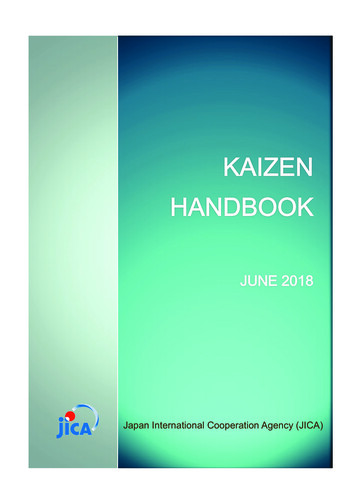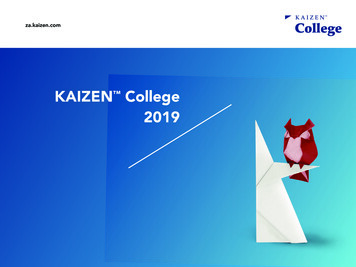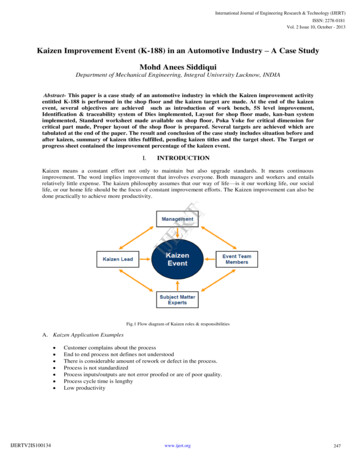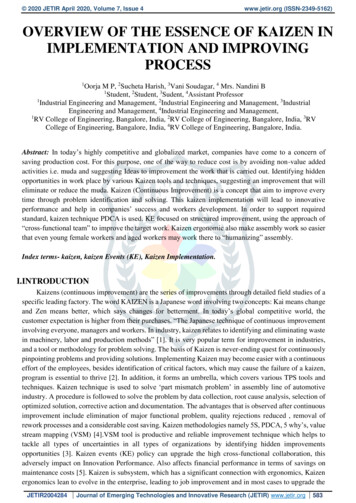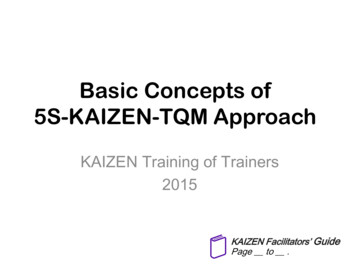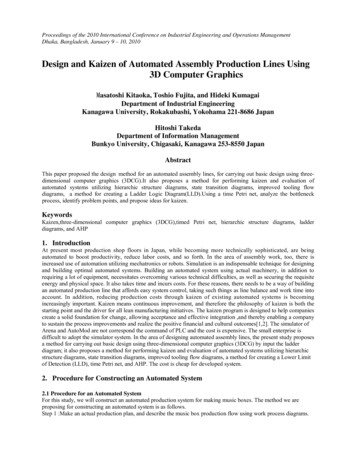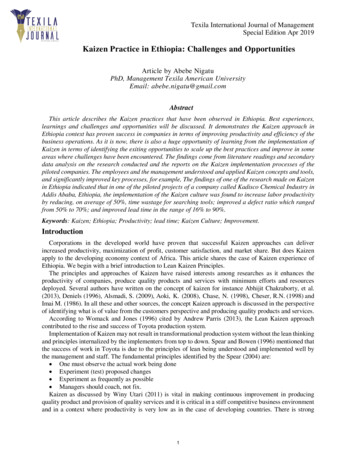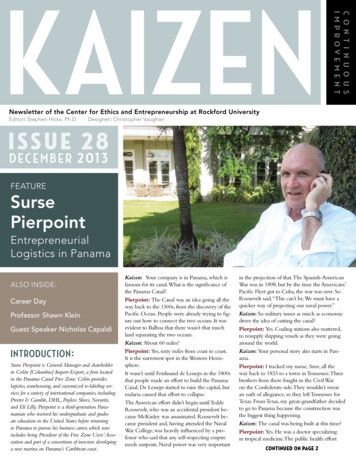
Transcription
C o n t i n u o u sImprovementKAIZENNewsletter of the Center for Ethics and Entrepreneurship at Rockford UniversityEditor: Stephen Hicks, Ph.D.Designer: Christopher VaughanI S S UE 2 8D EC E M B E R2 01 3FeatureSursePierpointEntrepreneurialLogistics in PanamaAlso inside:Career DayProfessor Shawn KleinGuest Speaker Nicholas CapaldiINTRODUCTION :Surse Pierpoint is General Manager and shareholderin Colón [Columbus] Import-Export, a firm locatedin the Panama Canal Free Zone. Colón provideslogistics, warehousing, and customized re-labeling services for a variety of international companies, includingProcter & Gamble, DHL, Payless Shoes, Novartis,and Eli Lilly. Pierpoint is a third-generation Panamanian who received his undergraduate and graduate education in the United States before returningto Panama to pursue his business career, which nowincludes being President of the Free Zone Users’ Association and part of a consortium of investors developinga new marina on Panama’s Caribbean coast.Kaizen: Your company is in Panama, which isfamous for its canal.What is the significance ofthe Panama Canal?Pierpoint: The Canal was an idea going all theway back to the 1500s, from the discovery of thePacific Ocean. People were already trying to figure out how to connect the two oceans. It wasevident to Balboa that there wasn’t that muchland separating the two oceans.Kaizen: About 60 miles?Pierpoint: Yes, sixty miles from coast to coast.It is the narrowest spot in the Western Hemisphere.It wasn’t until Ferdinand de Lesseps in the 1800sthat people made an effort to build the PanamaCanal. De Lesseps started to raise the capital, butmalaria caused that effort to collapse.The American effort didn’t begin until TeddyRoosevelt, who was an accidental president because McKinley was assassinated. Roosevelt became president and, having attended the NavalWar College, was heavily influenced by a professor who said that any self-respecting empireneeds outposts. Naval power was very importantin the projection of that.The Spanish-AmericanWar was in 1898, but by the time the Americans’Pacific Fleet got to Cuba, the war was over. SoRoosevelt said, “This can’t be.We must have aquicker way of projecting our naval power.”Kaizen: So military issues as much as economicdrove the idea of cutting the canal?Pierpoint: Yes. Coaling stations also mattered,to resupply shipping vessels as they were goingaround the world.Kaizen: Your personal story also starts in Panama.Pierpoint: I tracked my name, Surse, all theway back to 1833 to a town in Tennessee.Threebrothers from there fought in the Civil Waron the Confederate side.They wouldn’t swearan oath of allegiance, so they left Tennessee forTexas. From Texas, my great-grandfather decidedto go to Panama because the construction wasthe biggest thing happening.Kaizen: The canal was being built at this time?Pierpoint: Yes. He was a doctor specializingin tropical medicine.The public health effortContinued on Page 2
K AI ZEN122013From the Executive DirectorEconomists speak of the difference between incremental and disruptive innovations. Incrementalinnovations are small improvements to existingproducts, such as adding a music player or airbagto an automobile. Disruptive innovations are transformative, such as the automobile’s replacing thebuggy.Transportation has been revolutionized in themodern world, with new types of transportation—trains, airplanes, submarines—and innovationsthat have dramatically reduced costs. Before the invention of James Watt’s steamengine, it cost 5 to carry 100 pounds up theMississippi from New Orleans to Louisville.But with steam power, the cost “dropped to 2 by 1830, and soon fell to 25 cents,” writeshistorian Paul Johnson. Shipping on the Eire Canal in upstate NewYork, completed by 1825, was much fasterthan carts pulled by draft animals and costabout 95% less. In the twentieth century, Malcom McLean’sinvention of the standardized shipping container reduced loading costs by 97%.Our feature interview is with Surse Pierpoint,who runs a logistics company out of the Colón FreeTrade Zone, located at the Atlantic entrance to thePanama Canal. I spoke with Mr. Pierpoint in Panama City about his company, the Canal’s rich historyand huge impact on transportation, and how theCanal’s major expansion in 2014 is again poised toshake up shipping patterns the world over.All of our previous issues of Kaizen are available online, featuring interviews with entrepreneursin a variety of fields—from architecture to technology to marketing to venture capital to sports andmore. So please feel welcome to visit us on onlineat www.EthicsandEntrepreneurship.org.Stephen Hicks, Ph.D.2SURSE PIERPOINT continuedin controlling malaria was the importantthing before they actually started buildingthe canal.That’s how we got here.Kaizen: Where were you born?Pierpoint: In a hospital in Panama City.I lived about a year in Panama City, andthen our family moved to Colón on theAtlantic side.Kaizen: What was your education like?Pierpoint: Small-town Americana andvery protected. It was great growing upin the Canal Zone—even now on Facebook there are groups of people whoare wistful about their time growing upin the Canal Zone, because it was ideal,from our perspective as kids. It’s what Iimagine growing up in a small town inthe Midwest in the 1950s was like.Kaizen: You went to college in the USA?Pierpoint: I went to boarding schooland then college in North Carolina. Imet my wife there.Kaizen: Where in North Carolina?Pierpoint: Greensboro, North Carolinaat UNC. I took the easiest path: liberalarts. I got a double major: Spanish andLatin American Studies and Literature.Kaizen: At this point, did you have strongideas about what you wanted to do for acareer?Pierpoint: During my CommunistWorker Party days, I had a Cuban professor, and he and I had some very heatedarguments about how bad socialism hadbeen.This is around the time of the civilwar in Central America—Salvador, theFMLN.Kaizen: You were arguing the communist position?Pierpoint: Yes. My professor, SanchezBoudy, was saying, “You don’t understandwhat you are saying.” One big satisfaction is that I got to speak to him last year.I said, “Professor, you were absolutelyright.”Kaizen: Nice.Were you thinking at allabout career possibilities?Pierpoint: In my senior year, my fathersaid: “There might be an opportunity. Ithink I can convince the board.” I didn’thave anything else going on. My father’sprecondition was: “Get an MBA andthen come back and you can start working.”Kaizen: So you went to Thunderbird inArizona for your MBA.Pierpoint: American Graduate Schoolof International Management, informallyknown as Thunderbird.Their outlookwas that to be a well-rounded, international executive, you had to know notjust business but culture and language aswell.Kaizen: How long were you in Arizona?Pierpoint: That was a one year program.Then I started working at ColónImport-Export on October 1, 1984.Kaizen: So what was your first positionat Colón Import-Export?Pierpoint: In the warehouse. Dad said:“You’re not going to be an executive.You’re going to learn the business literally from the bottom-up.”That was in pre-container days: goodsarrived in a vessel, and they were takenoff the vessel and loaded onto a truck,and from the truck into the warehouse,where they were unloaded onto a pallet.Kaizen: All by hand?Pierpoint: All by hand.Kaizen: What services was Colón providing to its clients?Pierpoint: “Third-party logistics” is thetechnical term, which means that clientshire us for our facilities—warehouses andthe people—to receive and ship their orders to their clients in the region, whichat that time was mostly Panama andCentral America.Kaizen: So manufacturers anywhere inthe world who want to sell in CentralAmerica will send their stuff to ColónImport-Export, and you will warehouseit and send it on?Pierpoint: The beauty of it is that,because of the Canal, there were a lotof ships arriving in Panama. On theoutbound side, you could also re-exportthose goods.The complexity of dealingwith Latin America meant that it wasbetter to have a regional inventory instead of a country inventory. So Panamawas an attractive place to have a regionalinventory for servicing all of those countries.Kaizen: Colón operates in the ColónFree Trade Zone in Panama. How doesthe free zone work?Pierpoint: It’s a big bonded area which,from the Panamanian perspective, meansthat it’s duty free. As far as Panama isconcerned, those goods have not beenimported into Panama.They are in transit from where they were manufacturedto wherever their final destination is going to be. So it’s a fairly easy place to setup operations, it’s centrally located, and
your inventory then is that much closer to the final point ofconsumption.The free trade zone was an idea that evolved from theColón Chamber of Commerce. A director of Colón Import-Export was on that board. He was part of the boardthat created that idea and convinced the Panamanianpresident to sign it into law in 1948. We were one of thefirst companies to set up in the free zone.Kaizen: You began in the warehouse off-loading shipsand repackaging. How long did you do that?Pierpoint: Dad figured that after four years I hadlearned enough. I became general manager in 1989,about two weeks before the invasion. I remember because the board meeting where I was approved as generalmanager was the same day that General Manuel Noriegadeclared war on the United States. That’s something thatgets seared in your mind.Kaizen: Obviously, you had to prove yourself before becoming General Manager of a substantial organization.What were the big things that you had to learn or proveyourself on before you got that position?Pierpoint: Dealing with employees is the biggest challenge that any manager is going to have. Infrastructure—buying forklifts, buying trucks—is easy. Getting people torespond in the manner that you hope they are going to isthe biggest challenge—the empathy part of what it is thatyou want. What it is that I want, and how I can motivateyou to do that for the company?Kaizen: How do you do that?Pierpoint: One of my favorite sayings now is: “Peoplerespond to incentives.” About fifteen years ago we hired aconsultant, who is still working with us. I almost considerhim as a coach. He’s an industrial engineer by training.Kaizen: What’s his name?Pierpoint: Humberto Linero. Humberto taught me thatyou can change processes, but you always have to alignthose processes to make sure that the triangle of incentives—shareholders, clients, employees—always mesh.Kaizen: It has to be win-win-win.Pierpoint: Really. Because at the end of the day the employees want to earn more, the shareholders want to earnmore, but the clients want to pay less. So the challenge is,“Okay, if the shareholders want more dividends and theemployees want more salary, but the clients want to payless—how can you do that?” That seems like a tough nutto crack.What Humberto taught me is to align your processes sothat people want to chase that carrot. His philosophy isthat you want to pay what the market is paying; but theadditional “oomph” is going to come from people goingthe extra mile, because at the end of the day they want toearn a little bit of money.Kaizen: You joined the company in the 1970s, on thecusp of the personal computing revolution. Computerization went to a whole new level in the 80s and 90swith bar-coding, the Internet, and all of that. How didthat impact your business?Pierpoint: “Warehouse management systems” didn’t exist as a term.We had to create our own software to be ableContinued on Page 4CeE NewsCareer DayNearly 200 high school students from the stateline area visited Rockford Universityon November 7 for Career Day. The Economics, Business, and Accountingdepartment hosted the event and over 40 volunteers from local businesses andagencies shared their experiences and advice for a variety of career options.Profile: Dr. Shawn KleinCEE professor Shawn Klein had a productive year. In addition to his popular SportsEthics course, Dr. Klein developed a new course — The Philosophy of Sport. Dr.Klein also started the Sports Ethicist Podcast, which already has 17 episodes and isavailable on iTunes. Dr. Klein is planning a third annual Sports Studies Symposiumfor April 25, 2014. Finally, he was recently quoted by Sports Illustrated on the issue ofrules in sport. Details about the above and more can be found at sportsethicist.com.Guest Speaker: Nicholas CapaldiDr. Nicholas Capaldi visited Rockford University on September 17. He gave a talkentitled “The Lockean Liberty Narrative versus the Rousseau Equality Narrative.”A video interview with Dr. Capaldi is available on the CEE website.3
Pierpoint at Colón Import-Export and employeesSURSE PIERPOINT, continuedto do that. I was working already when the faxcame along, and I told my dad that we neededto get a fax. He said,“Why do we need a fax?”Because we had dealt with correspondence—orders would come in the mail, and then thetelex came along, and then the fax came along.Everything sped up.Then computers came along. My dad had avery clear vision that we needed to be able toprovide tracking and other information to ourclients. But in the pre-Internet days that meantexpensive long-distance phone calls.The Internet meant that we were actually able to fulfillthat vision of being able to give our clients visibility online, which was the Holy Grail.Kaizen: How many employees do you havecurrently?Pierpoint: We have 500 employees.Kaizen: When you came on board in the 1970s,approximately how many employees did youhave?Pierpoint: One hundred.Kaizen: If it’s not confidential, can you say thesales numbers between then and now?Pierpoint: If we express it as a fraction of sales,our net income is less than one tenth of onepercent of sales because of the warehousingcomponent, and we represent about twentypercent of the total Free Zone turnover of 15billion (USD) in annual sales.Kaizen: In your role as General Manager, youhave people management responsibilities, process management, including all of the technology. Is another part financial?Pierpoint: That’s where the board comes in.I’m the warehouse guy, and I will admit mydeficiencies on the finance side. Fortunately,the company has always been able to fund itself.4And now in Panama the cost of capital is fairlylow. So if you have a good trajectory—thebanks have always been very open, and we havea good relationship with the local banks to helpus grow.Kaizen: Another job is bringing in clients.Currently you have an impressive roster of clients: Procter & Gamble, Payless Shoes, and thepartnership with DHL.“Getting people torespond in the manner that you hopethey are going tois the biggest challenge.”Pierpoint: And Novartis.Kaizen: Yes. Do clients seek you out or doyou seek them out?Pierpoint: One of the challenges is how toget new clients. My experience is that wordof-mouth is the best way.Kaizen: Two of your major clients are pharmaceuticals?Pierpoint: Yes. Novartis and AstraZeneca.Kaizen: Novartis is out of Switzerland. Whatdo you do for them?Pierpoint: Like everybody else, they shipfrom their factories all over the world toPanama. From there we service their clientorders for the region, which is CentralAmerica, the Caribbean,Venezuela, Colombia, and Ecuador.Kaizen: On the warehouse tour yesterday,Eduardo Lazarus showed me rooms whereeverything was taken out of boxes and labelswere applied. Is that another part of the service that you offer?Pierpoint: That’s a value-added portion ofthe service that isn’t just moving the goods butdoing something with the goods. The Standard Export Pack means that when the goodsarrive to Panama, our clients don’t necessarilyknow where they are going to go at the moment, so they are holding that inventory.Kaizen: It could go to Peru; it could go toGuatemala.Pierpoint: It could go anywhere. That’s thebeauty; it takes out the uncertainty of trying toanticipate what each country is trying to buy.But, in general, if you try to project on a regional level, the fact that one country may notmeet that budget means that another countrymight take up that product so you don’t haveto worry; it smooths it out.You can say, “Okay,I expected to sell this much in this countryand it didn’t happen, but I have a country overhere.” So they just shift that product.What that means is that product can then becustomized. In pharmaceuticals, the numberone client in Latin America is the government.So government tenders tend to have specificrequirements that require you to identify thatthe product is property of, say, the HonduranSocial Security. So you have to do ink-jettingand labeling and that kind of stuff. That iswhat we do in that value-add portion that yousaw.Kaizen: And Payless Shoes. Did that clientalso come through DHL?Pierpoint: Yes. At first we thought: shoes?Traditionally we had been a pharmaceuticals company. But that relationship has beentremendous. We’ve really developed systems:everything gets scanned in and out.Kaizen: Payless is an American company?Pierpoint: Based in Topeka, Kansas.Kaizen: Though the shoes are manufacturedin China, and then they come to Panama?Pierpoint: The model before us was Chinato Long Beach, Long Beach to Topeka, Topekato Miami, and Miami to the stores.Kaizen: A lot of transfers.Pierpoint: That was a very cumbersome supply chain. They saw Panama as an opportunitywhere it would be China to Panama andPanama to the stores.Kaizen: Take a standard work week for youas a general manager. How do you typicallyspend your time? How much cultivating clients, dealing with existing clients, meetingwith your board, on the floor?Pierpoint: Dad taught me that the best kindof management is by walking around and visiting clients. One of his favorite things to dowas to go see an operation, like Novartis’s in
Europe. And he would always pick up something from walking around and just lookingfrom the perspective of “What are you doingthat I can copy and use in Panama?”Once a month I have a board meeting. I willbe in the office looking at results; meetingwith the managers who handle the differentoperations. I have five executives under me,and each one is in charge of a different area:finance, quality, operations, technology, andhuman resources. We’ll review what is happening with the clients. What are the issues?There’s always a problem. We’ve got the pushat the end of the month when we need to beable to ship everything out before the last dayof the month in order to book sales. The lastweek is when the pressure is compressed.Kaizen: How much travel is involved? Payless is in the United States, as is Procter &Gamble. Novartis is in Switzerland.Pierpoint: In my dad’s days it was a trip toSwitzerland to meet with Novartis. What themodern corporate world has tried to pushthat down to a regional level. So it’s meetingin Guatemala or Costa Rica or Bogotá withthe regional managers.Of course with Skype, email, and phone,there is not so much visiting. Maybe that isan area where I need to improve. There isstill a huge value in face time and buildingrelationships.Kaizen: You talked earlier about the freezone and the history of the Panama Canal.There was a failed effort to build it in the1880s. Why did it not work?Pierpoint: Malaria and yellow fever. DeLesseps was the king of the world because hehad done the Suez Canal. He figured, “Heck,I did it in Suez. Panama is the next narrowspot in the world where a canal is needed,and I know how to do canals. So let’s go toPanama and do it.”Kaizen: But he underestimated malaria andyellow fever.Pierpoint: Malaria, from the French mal air.People figured that it was the bad air fromthe swamp that caused yellow fever. Paradoxically, that was part of the lore from mygreat-grandfather. In the hospitals in Colónit was very typical to have little trays of wateron the foot of each hospital bed because youdidn’t want the ants to get into the bed. Thatlittle pool of water became a place wheremosquitoes could breed. But they didn’tknow any better.Kaizen: The canal was built successfully andopened in 1914?Pierpoint: Yes.Kaizen: When did the American effort tobuild the canal begin?Pierpoint: 1905.Pierpoint overlooking the new Gatun locks constructionKaizen: By then malaria and yellow feverhad been figured out?Pierpoint: Yes, during the Spanish-AmericanWar in Cuba—by Dr.Walter Reed, who hasthat army hospital in D.C. named after him.He, along with some Cuban doctors, figuredout that the vector was the mosquito.That’swhere my great-grandfather got involved, inthe public health effort in trying to control thesituation so that at least the challenge wasn’tgoing to be that workers were dying off. Incidences of death by malaria dropped precipitously.Kaizen: Wonderful.There were other engineering challenges.The Atlantic and the Pacificaren’t at the same sea level, and the interiorwaterways are also at different levels. So theybuilt locks on the Pacific side and on the Atlantic side, and flooded the middle to make agiant lake.Pierpoint: The original design was to copythe French effort to make it sea level. Oneengineer started the effort, but it was a mess.There wasn’t much digging going on and, ofcourse, the tropical environment made it difficult.John Frank Stevens, the second engineer, camealong. He was involved in building railroads inthe American West. I think he worked on theeffort to put a railroad through the Rockies, sohe was a brilliant engineer. He came throughand figured out: “Okay.What we need to dois to get the dirt out of here as quickly as possible.” He came up with some very innovativeideas—steam shovels and trains to move thedirt in a very efficient manner.But his design was: “We aren’t going to do sealevel. Let’s do locks.”The design is that 60% or70% of the canal is the flooding of a river valley to create Gatun Lake.Then the portion ofdigging through the Continental Divide andout to the Pacific was the digging challenge.Parallel to the digging was the creation of thelocks and the flooding.That was the inaugural moment—the blowing up of the dyke inGamboa where the Chagres River met thedyke. Once the digging portion was completed, water flooded in.That was in 1914.Kaizen: Awesome.What was the nature ofthe business arrangement between the UnitedStates and Panama?Pierpoint: There’s an interesting “black” legend of how Panama was created.Was it truly abunch of Panamanian patriots who wanted tobe free from Colombia? Or was it New Yorkmoney that convinced and funded the revolution, and the United States backed them afterColombia said to the United States: “No.Wedon’t want to give you an option to build acanal.”The United States then chose the pathof least resistance: “Well, if we can’t convinceColombia, let’s let Panama become independent and then we can negotiate with Panamaand not with Colombia.”One of the first acts of the Panamanian government was to sign a treaty with the UnitedStates to grant them, in perpetuity, a 50-milewide by 50-mile long sector of the middle ofthe country to operate as they saw fit. So it wasa piece of the United States in the middle ofthe Republic of Panama.Kaizen: And that revolutionized world transportation.How long does it typically take, to go fromone end of the canal to the other end? Andhow much does it cost to send a ship through,depending on the size of the ship?Pierpoint: The transit on average is ten hours.The cost can be all the way up to 350,000 or 400,000 for transit.The off-set of that is that,though that sounds like a lot of money, if I hadContinued on Page 65
Pierpoint (right) with Stephen HicksSURSE PIERPOINT, continuedto go another way, those days of operation fromthe vessel makes the amount worthwhile.Kaizen: In 1999 the U.S. formally transferredownership of the Canal Zone to Panama, anda few years later there was a decision to expandthe canal.Pierpoint: Well, the original lock design—theArmy Corps of Engineers said, “If this is goingto last a hundred years, how big can boats getinto the future?”That’s what is really amazing,the foresight of these guys to say, “Let’s makeit really big.There is nothing on the drawingboards for that size, but we have to think longterm.” So that is what we saw with the expansion: 1,000 feet long by 100 feet wide. Peoplewere like, “You’re nuts! That’s crazy! That’s waytoo big” “Maybe it is now,” they replied, “butwe don’t know what the future is going to belike.”That created what is known as the Panamax type of a vessel with the maximum weightand width that can fit through the locks.Kaizen: The engineers back in the 20th centuryhad good foresight, but nonetheless technology has advanced far and there are a significantnumber of super ships that can’t get throughthe current canal.Pierpoint: Yes. So a few years ago, there wasa national referendum.You know the movieCars?Kaizen: Yes.Pierpoint: The rise of the interstate highwaysystem in the United States meant that Route66 was no longer the main road. I use thatexample to highlight the fact that the carriers,especially the container carriers, are lookingto lower the cost per container of moving aboat around the world. So from the year 2000,Panama took over the Canal, they started tothink: We are coming up on 100 years, and weneed to widen the canal because we are seeingthe trends in the industry. If we don’t widen it,6we’re going to be Route 66 instead of Interstate 40. In 2006, a national referendum wasapproved overwhelmingly by over 70 percentof the population.Kaizen: This is a multi-billion dollar project.Pierpoint: About 5.5 billion.Two new locksand raising the level of the lake to have morewater, deepening the draft for the bigger vessels—not just in the lakes, but in the approacheson both the Atlantic and Pacific sides cominginto the new chambers.Kaizen: Currently, how many ships can be inthe system at a given time?Pierpoint: Between 35 and 40 per day.Kaizen: When the new locks open in 2014 or2015, the current locks will still be in operation.What’s the anticipated number of shipsthat will be able to go through?Pierpoint: They expect to be able to doublethe capacity.Kaizen: Currently how much revenue does thecanal generate in transit fees?Pierpoint: It shifted over the years.TheAmericans always ran the canal on a cost-basis:“We are going to charge whatever it costs.”ThePanamanian administration adopted a muchmore business-like attitude: “Let’s charge whatthe market will bear.”One of the proud facts of the Panamanianadministration of the canal is that what we’vegotten from 2000 to 2011 far surpassed whatwe got from the United States as a stipend forrunning the canal from 1914 to 2000.We aretalking about over a billion dollars last yearthat the canal gave to the national treasury. It isexpected that when we double the capacity, it’sgoing to be more than two billion.Kaizen: Most of that money gets invested ininfrastructure?Pierpoint: It goes into the kitty to deal withinfrastructure: security, health, and education.Kaizen: How is the rest of the world reactingto the Canal expansion? For example, it affects the ports on the west coast of the UnitedStates.Pierpoint: There is a website calledbeatthecanal.com, which is an effort by a groupof Californians worried about what the Canalis going to mean for Los Angeles-Long Beachtraffic. It might mean up to 20 percent lessmovement through L.A.-Long Beach, whichis the largest port in the United States. So theyare very concerned about what is called the allwater route: Asia, through the canal, to the eastcoast of the United States.Demographically, most of the U.S. populationlives east of the Mississippi. China is the UnitedStates’ factory. All of those goods have to get tothe east coast and right now, L.A.-Long Beachis the preferred destination.Kaizen: Is the east coast of the United Statesprepared for more traffic and larger ships?Pierpoint: The Washington Post had an articlerecently that is a good summary of the different ports. The Savannah River has to bedredged for the Port of Savannah; the BayonneBridge in New Jersey has to be raised becausethese larger vessels can’t currently come underthe bridge. That article mentioned somethinglike 6 billion in different projects along thesemajor ports, which are all vying to be the destination for these carriers. Miami is investingmoney; Savannah is investing money; Charleston is investing money; the Port of New YorkNew Jersey is investing money. They all wantto be the place where those big ships willstop and off-load their containers. So they arecompeting for the L.A.-Long Beach marketas well.Kaizen: Fascinating. To come back to youpersonally: you have been GM at ColónImport-Export for 23 years. What will you bedoing over the next few years?Pierpoint: One of the challenges is to do thesame thing my dad did. I came aboard rightaround the time he was looking to transition.Who’s going to replace me?Kaizen: What will the transition involve?Pierpoint: To bring somebody on board whowill have five or six good years of training sothat he will be in a position to take over.Kaizen: A significant amount of what is donein your warehouses now is by hand. Do yousee improvements in technology on your horizon?Pierpoint: Kiva Systems was bought byAmazon. With Kiva, instead of a packer going to the product, the product is brought tothe packer. Part of what I do as well is keepabreast of what is happening in the industry.It’s still the cost of the robot versus the cost oflabor, and it’s still heavily in favor of the costof labor.Kaizen: You have interests outside of work,including your busy family, and you are on theFree Zone Users’ Association Board (FZUA).Pierpoint: I got on the board in 1988, and Iwas very honored.Kaizen: What is the FZUA’s function?Pierpoint: It was created in 1980 as a placewhere all of the users could get together andhave a channel to talk to the government.Every five years a new administration comesin, and that new administration, unfortunately,doesn’t know much about the free
Kaizen: Your company is in Panama, which is famous for its canal. What is the significance of the Panama Canal? Pierpoint: The Canal was an idea going all the way back to the 1500s, from the discovery of the Pacific Ocean. People were already trying to fig-ure out how to connect the two oceans. It was evident to Balboa that there wasn't that much
